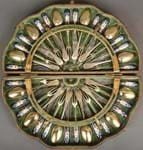
Early 18th century glass flask that once belonged to the extensive travelling apothecary of Augustus the Strong – €13,000 (£11,305) at Spik.
Photo: Johannes Zappe
Spik (20% buyer’s premium) of Berlin dispersed a collection of apothecary vessels in various shapes, sizes and materials on October 6.
Demand was good, with over 80% of the 77 pieces finding buyers, often for much more than the guides.
With one exception, the results ranged from €50 to €2800.
That stand-out price came for an early 18th century glass flask with an interesting provenance.
Healthy travel
It once belonged to the extensive travelling apothecary of Augustus the Strong, Elector of Saxony and King of Poland. This comprised five iron-mounted oak chests filled with numerous containers for potions and medicines. Nowadays, only 24 of the glass vessels are thought to have survived.
As far as is known, all the flasks and bottles were manufactured in the glassworks in Heidelbach, south of Dresden, where Augustus had his court. The well-documented 5in (13cm) high flask in clear glass was decorated in coloured enamel with the royal coat of arms, the crown, sceptre and sword on a background of an ermine cloak.
Like the other known pieces, it is dated 1719 and bears the initials AR for Augustus Rex.
The flask once contained Ess: Theriaca or essence of Theriac.
In the 18th century, this extract was considered to be a cure for any number of ailments and an antidote to poisons. It was sometimes called the ‘Queen of medicines’ and was primarily a mixture of numerous herbs and spices to which more exotic ingredients were added.
According to some recipes, the flesh of a viper was essential, while other apothecaries included opium in their mixture.
Bidding started at €5000 and after many exchanges, the hammer fell at €13,000 (£11,305). Appropriately, the buyer was a chemist.
£1 = €1.15














